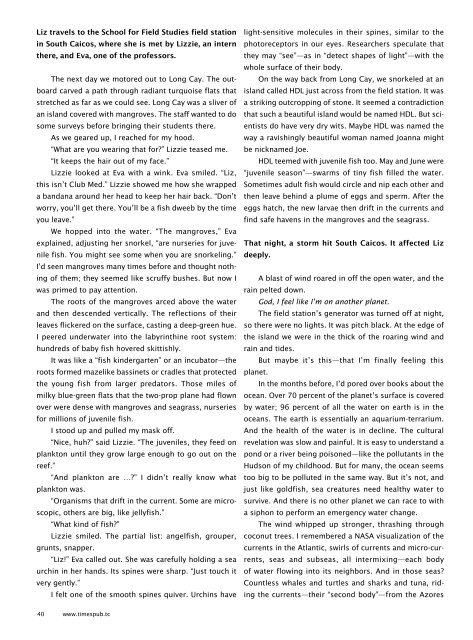Times of the Islands Winter 2015-16
Presents the "soul of the Turks & Caicos Islands" with in-depth features about local people, culture, history, environment, businesses, resorts, restaurants and activities.
Presents the "soul of the Turks & Caicos Islands" with in-depth features about local people, culture, history, environment, businesses, resorts, restaurants and activities.
Create successful ePaper yourself
Turn your PDF publications into a flip-book with our unique Google optimized e-Paper software.
Liz travels to <strong>the</strong> School for Field Studies field station<br />
in South Caicos, where she is met by Lizzie, an intern<br />
<strong>the</strong>re, and Eva, one <strong>of</strong> <strong>the</strong> pr<strong>of</strong>essors.<br />
The next day we motored out to Long Cay. The outboard<br />
carved a path through radiant turquoise flats that<br />
stretched as far as we could see. Long Cay was a sliver <strong>of</strong><br />
an island covered with mangroves. The staff wanted to do<br />
some surveys before bringing <strong>the</strong>ir students <strong>the</strong>re.<br />
As we geared up, I reached for my hood.<br />
“What are you wearing that for?” Lizzie teased me.<br />
“It keeps <strong>the</strong> hair out <strong>of</strong> my face.”<br />
Lizzie looked at Eva with a wink. Eva smiled. “Liz,<br />
this isn’t Club Med.” Lizzie showed me how she wrapped<br />
a bandana around her head to keep her hair back. “Don’t<br />
worry, you’ll get <strong>the</strong>re. You’ll be a fish dweeb by <strong>the</strong> time<br />
you leave.”<br />
We hopped into <strong>the</strong> water. “The mangroves,” Eva<br />
explained, adjusting her snorkel, “are nurseries for juvenile<br />
fish. You might see some when you are snorkeling.”<br />
I’d seen mangroves many times before and thought nothing<br />
<strong>of</strong> <strong>the</strong>m; <strong>the</strong>y seemed like scruffy bushes. But now I<br />
was primed to pay attention.<br />
The roots <strong>of</strong> <strong>the</strong> mangroves arced above <strong>the</strong> water<br />
and <strong>the</strong>n descended vertically. The reflections <strong>of</strong> <strong>the</strong>ir<br />
leaves flickered on <strong>the</strong> surface, casting a deep-green hue.<br />
I peered underwater into <strong>the</strong> labyrinthine root system:<br />
hundreds <strong>of</strong> baby fish hovered skittishly.<br />
It was like a “fish kindergarten” or an incubator—<strong>the</strong><br />
roots formed mazelike bassinets or cradles that protected<br />
<strong>the</strong> young fish from larger predators. Those miles <strong>of</strong><br />
milky blue-green flats that <strong>the</strong> two-prop plane had flown<br />
over were dense with mangroves and seagrass, nurseries<br />
for millions <strong>of</strong> juvenile fish.<br />
I stood up and pulled my mask <strong>of</strong>f.<br />
“Nice, huh?” said Lizzie. “The juveniles, <strong>the</strong>y feed on<br />
plankton until <strong>the</strong>y grow large enough to go out on <strong>the</strong><br />
reef.”<br />
“And plankton are …?” I didn’t really know what<br />
plankton was.<br />
“Organisms that drift in <strong>the</strong> current. Some are microscopic,<br />
o<strong>the</strong>rs are big, like jellyfish.”<br />
“What kind <strong>of</strong> fish?”<br />
Lizzie smiled. The partial list: angelfish, grouper,<br />
grunts, snapper.<br />
“Liz!” Eva called out. She was carefully holding a sea<br />
urchin in her hands. Its spines were sharp. “Just touch it<br />
very gently.”<br />
I felt one <strong>of</strong> <strong>the</strong> smooth spines quiver. Urchins have<br />
light-sensitive molecules in <strong>the</strong>ir spines, similar to <strong>the</strong><br />
photoreceptors in our eyes. Researchers speculate that<br />
<strong>the</strong>y may “see”—as in “detect shapes <strong>of</strong> light”—with <strong>the</strong><br />
whole surface <strong>of</strong> <strong>the</strong>ir body.<br />
On <strong>the</strong> way back from Long Cay, we snorkeled at an<br />
island called HDL just across from <strong>the</strong> field station. It was<br />
a striking outcropping <strong>of</strong> stone. It seemed a contradiction<br />
that such a beautiful island would be named HDL. But scientists<br />
do have very dry wits. Maybe HDL was named <strong>the</strong><br />
way a ravishingly beautiful woman named Joanna might<br />
be nicknamed Joe.<br />
HDL teemed with juvenile fish too. May and June were<br />
“juvenile season”—swarms <strong>of</strong> tiny fish filled <strong>the</strong> water.<br />
Sometimes adult fish would circle and nip each o<strong>the</strong>r and<br />
<strong>the</strong>n leave behind a plume <strong>of</strong> eggs and sperm. After <strong>the</strong><br />
eggs hatch, <strong>the</strong> new larvae <strong>the</strong>n drift in <strong>the</strong> currents and<br />
find safe havens in <strong>the</strong> mangroves and <strong>the</strong> seagrass.<br />
That night, a storm hit South Caicos. It affected Liz<br />
deeply.<br />
A blast <strong>of</strong> wind roared in <strong>of</strong>f <strong>the</strong> open water, and <strong>the</strong><br />
rain pelted down.<br />
God, I feel like I’m on ano<strong>the</strong>r planet.<br />
The field station’s generator was turned <strong>of</strong>f at night,<br />
so <strong>the</strong>re were no lights. It was pitch black. At <strong>the</strong> edge <strong>of</strong><br />
<strong>the</strong> island we were in <strong>the</strong> thick <strong>of</strong> <strong>the</strong> roaring wind and<br />
rain and tides.<br />
But maybe it’s this—that I’m finally feeling this<br />
planet.<br />
In <strong>the</strong> months before, I’d pored over books about <strong>the</strong><br />
ocean. Over 70 percent <strong>of</strong> <strong>the</strong> planet’s surface is covered<br />
by water; 96 percent <strong>of</strong> all <strong>the</strong> water on earth is in <strong>the</strong><br />
oceans. The earth is essentially an aquarium-terrarium.<br />
And <strong>the</strong> health <strong>of</strong> <strong>the</strong> water is in decline. The cultural<br />
revelation was slow and painful. It is easy to understand a<br />
pond or a river being poisoned—like <strong>the</strong> pollutants in <strong>the</strong><br />
Hudson <strong>of</strong> my childhood. But for many, <strong>the</strong> ocean seems<br />
too big to be polluted in <strong>the</strong> same way. But it’s not, and<br />
just like goldfish, sea creatures need healthy water to<br />
survive. And <strong>the</strong>re is no o<strong>the</strong>r planet we can race to with<br />
a siphon to perform an emergency water change.<br />
The wind whipped up stronger, thrashing through<br />
coconut trees. I remembered a NASA visualization <strong>of</strong> <strong>the</strong><br />
currents in <strong>the</strong> Atlantic, swirls <strong>of</strong> currents and micro-currents,<br />
seas and subseas, all intermixing—each body<br />
<strong>of</strong> water flowing into its neighbors. And in those seas?<br />
Countless whales and turtles and sharks and tuna, riding<br />
<strong>the</strong> currents—<strong>the</strong>ir “second body”—from <strong>the</strong> Azores<br />
40 www.timespub.tc

















